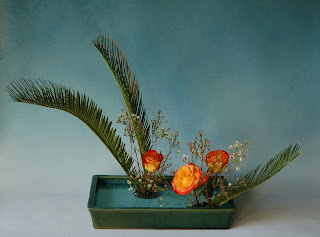This is my first try to put together a kakeiho lesson in slide show.
Saturday, January 31, 2009
West Valley Art Museum Exhibition and Demonstration
Sunday, January 25, 2009
Ikebana lessons 01/23/2009
ikebana study--intertwine




Weaving, or intertwine, is a technique introduced in the new text book. It's a very useful skill to have. Weaving changes the form, texture of the original materials.
Last Friday, I picked up a few fan palm leaves from one of my neighbors yard. (The cleaning crew were trimming the palm tree.) I studied the weaving technique. I weaved into three parts, then tried to arrange the weaved palm leave. It turned out some nice sculptural forms. The following is one of the forms I liked the most. (Same arrangement with different views.)
Sunday, January 18, 2009
ikebana study



(1) Palm spathes (dry), bougainvillea, and dry willow grass.
Every year, palm trees have to been trimmed. I found those stems were interesting, and saved a few for later use. The container I used in this arrangement was inspired by Kimei Yasuhara. But it's such a strong container, it requires some strong, unique materials. It's really fun to make this arrangement. I actually tried a few times, took pictures, and this was the one I liked based on the outcome of the photo. Sometimes, it's difficult to decide which arrangement I like the most, without input of other fine ikebana artists' critic. Photo is the way to do self critic.
(2) & (3) eucalyptus, carnations.
This container was inspired by Suzuki Osamu. I like its geometric shape. Again, it's a very unique and strong container. This is the first time I try. I want to try to use it more in the future. It's not that difficult to use, surprisingly.
Ikebana lessons 01/17/2009










(1) Yuko, arrangement with dried materials: Mitsumata, quince, and tulips
The diagonal lines of mitsumata cut through the mostly dark container. They shed off the heaviness of the container and make the arrangement work. It would be more interesting after a few days when the quince flowers bloom.
(2) & (3) Kelly, No 5 variations
(4) & (5) Sandy, No 2 variation, slanting
(6) Yuko, branches with fruits
(7) Eileen, branches only (two or more different kinds of branches)
(8) Mary, free style
(9) Alice, free style
(10) Wei, free style
Sunday, January 11, 2009
Ikebana lessons 01/10/2009











(1) Sharon (Colorado Spring), free style, disassembling and re-arranging
(2) Eileen, free style, disassembling and re-arranging
Dissembling and re-arranging is a good technique to master. When you have only a limited amount of material, in this case, only one kind of material-coffee bean, dissembling the material yields two different materials. In this case, you can make the arrangement more interesting. In Sharon's arrangement, the colorful containers has already made the setting interesting. The coffee beans and their stems are simple enough that they don't need to add any color to the arrangement. Obviously, the containers are part of the arrangement. Eileen's arrangement is also straight forward. Stems form the curve lines, coffee beans are the focal point.
(3) Wei, straight and curve lines
(4) mary, straight and curve lines
(5) Donna, hanging style, No 4.
(6) Coni, free style
(7) Momoe, free style
(8), (9) Sandy, No. 1 and No. 2 variation
(10), (11) May, No. 1 variation
Saturday, January 3, 2009
Happy New Year, and happy new arrangements















(1) Ping, free style
(2) Sandy, free style
(3) Yuko, simplified
(4) Elsa, No 8 variation, moribana/nageire
(5) Donna, No 8 variation, moribana/nageire
(6) Yuko, simplified
(7) Janelle, Basic slanting moribana
(8) Sandy, No 1 variation upright
(9) Wei, curve lines
(10) Mary, curve lines
(11) Elsa, vertical arrangement
(12) Ping, maze-zashi
(13) Yuko, Maze-zashi
(14) Kelly, free style
(15) Kelly, No 4 variation
Subscribe to:
Posts (Atom)












